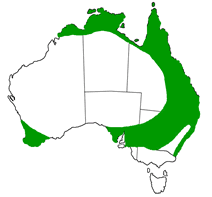Today I will write something about carpet python morphs and subspecies. As you know Carpet python group consist of several subspecies and morphs. I think that in future this species will be way more popular than now. Carpet pythons for sure in future will have more morphs than popular ball python. This snakes are semi - arboreal and active during the day that make from them very good exposition snake. From that what I hear their poo don't smell so bad like some other snakes. :P
Diamond Python (Morelia spilota spilota)
-------------------------------------------------------------------------------------------------
I will start from main subspecies Morelia spilota spilota popularly known as diamond python. This is a main subspecies from Australia and python who's live on the most southern territories and on the highest altitude from all pythons. These python lives on very various habitats from urban, woodlands to rocky habitat. Diamond pythons mainly feed on mammals but from time to time they also eat birds and lizards. Some populations around Lake Victoria in Australia are threatened with extinction. Diamond's can survive in lower temperatures than other carpets and stay dormant up to six months during one year. During breeding season males are don't fight with each other. Diamond pythons instead of fighting are making breeding balls similar to those like in anaconda, where many males try to copulate with one female. It is possible for female to grow up to 9 ft (but usually much smaller).
Wild Diamond
http://ectotherms.net/kyherpsoc/Propagating%20Carpet%20Pythons%20Webpage_files/image017.jpg
Black and white form is rarer than yellow in trade.
http://www.ryanphotographic.com/diamond%20python.jpg
Diamond python yellow form
http://www.pythonidae.nl/Pythonidae
Dark Diamonds
http://www.cuttingedgemorelia.com/site/images/stories/CuttingEdgeMorelia/Section_Projects/Diamonds_Dark/Gallery/black_diamond.jpg
Striped Diamond
http://www.snakeranch.com.au/images/sendbinary.asp?width=645&path=imagesDB/wysiwyg/Diamond(Tareelocale).JPG
Jungle carpet python (Morelia spilota cheynei)
-------------------------------------------------------------------------------------------------
This subspecies lives in the most tropical habitat and is the smallest from all carpets they are don't longer than 6 - 7 ft. Jungle carpets lives in Queensland and Cape York Peninsula. These is the most arboreal species from all carpets and they inhabit a rain forest canopy.
Wild form
http://www.oakvalefarm.com.au/images/jungle_carpet_python.jpg
Ivory black and white form
http://www.theradzoo.com/wp-content/uploads/2012/09/Jungle-Carpet-Python.jpg
Tully locality jungle
http://i305.photobucket.com/albums/nn214/Red-Ink-Buldogs/Greyham/G15_zps77543b34.jpg
Babinda locality jungle
http://trexreptiles.net/wp-content/uploads/2012/08/babinda-4.jpg
Palmerston locality jungle
http://ih2.redbubble.net/image.4059535.5274/flat,550x550,075,f.jpg
Atherton localities jungle
http://www.ebmorelia.com/publishImages/Collection~~element219.jpg
Zebra jungle
Zebra is the co - dominant trait. The zebra gene is gene from jungle pythons.
Zebra is the co - dominant trait. The zebra gene is gene from jungle pythons.
http://www.ukpythons.com/imgs/gallery/zeb3.jpg
Super Zebra
http://www.ukpythons.com/imgs/gallery/szeb1.jpg
Striped/Tiger form
http://www.moreliapythonradio.com/publishImages/Morphs-of-the-Morelia-complex~~element87.jpg
Highlighter jungle
http://www.australianaddiction.com/JCP_Highlighter2013.jpg
http://www.moreliapythonradio.com/publishImages/Morphs-of-the-Morelia-complex~~element87.jpg
Highlighter jungle
http://www.australianaddiction.com/JCP_Highlighter2013.jpg
Coastal carpet python (Morelia spilota mcdowelli)
-------------------------------------------------------------------------------------------------
Coastal carpet python is the biggest subspecies usually growth to 7 ft but 14 ft specimens are recorded. Coastals lives in wide range of habitats but mainly in forests. Range from Cape York peninsula to South Wales. This taxa is the most variable in patterns and colors which is presented in variety of morphs.
Wild form
http://www.ukpythons.com/imgs/gallery/BrF.jpg
High contrast coastal
http://static.squarespace.com
High contrast tiger coastal
http://ectotherms.net/kyherpsoc/Propagating%20Carpet%20Pythons%20Webpage_files/image077.jpg
Red coastal
http://www.moreliapythonradio.com/publishImages/Morphs-of-the-Morelia-complex~~element239.jpg
Red tiger
http://www.moreliapythonradio.com/publishImages/Morphs-of-the-Morelia-complex~~element238.jpg
MPenn Line coastal
https://static.squarespace.com/static/502928b784ae02c19c94a1d1/502ad72a84ae8782450178d7/502ad730e4b0d642355d996c/1344984880495/Sonja%203.jpg?format=750w
Ocelot caramel
http://www.moreliapythonradio.com/publishImages/Morphs-of-the-Morelia-complex~~element247.jpg
MORE MORPHS Click Read More!





.JPG)

































